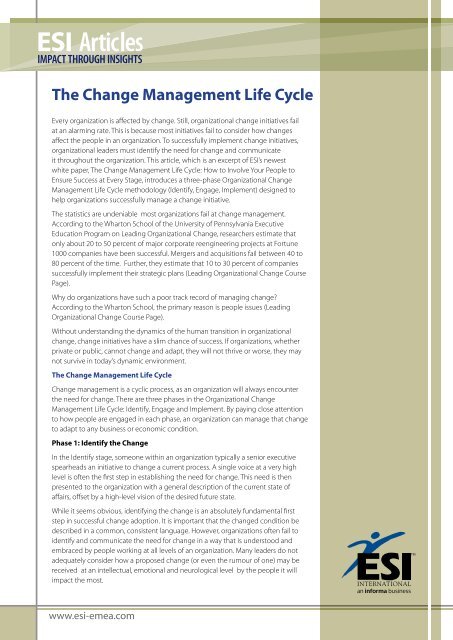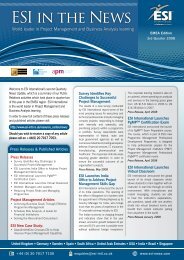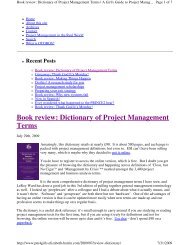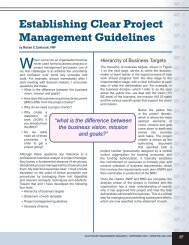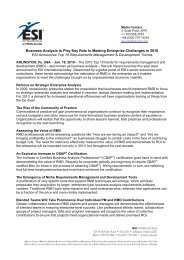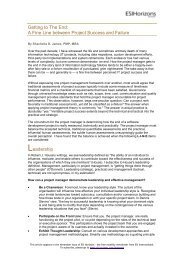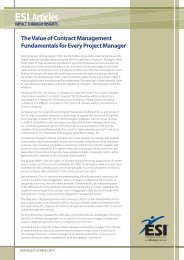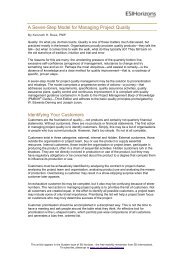The Change Management Life Cycle - ESI International
The Change Management Life Cycle - ESI International
The Change Management Life Cycle - ESI International
You also want an ePaper? Increase the reach of your titles
YUMPU automatically turns print PDFs into web optimized ePapers that Google loves.
<strong>ESI</strong> Articles<br />
IMPACT THROUGH INSIGHTS<br />
<strong>The</strong> <strong>Change</strong> <strong>Management</strong> <strong>Life</strong> <strong>Cycle</strong><br />
Every organization is affected by change. Still, organizational change initiatives fail<br />
at an alarming rate. This is because most initiatives fail to consider how changes<br />
affect the people in an organization. To successfully implement change initiatives,<br />
organizational leaders must identify the need for change and communicate<br />
it throughout the organization. This article, which is an excerpt of <strong>ESI</strong>’s newest<br />
white paper, <strong>The</strong> <strong>Change</strong> <strong>Management</strong> <strong>Life</strong> <strong>Cycle</strong>: How to Involve Your People to<br />
Ensure Success at Every Stage, introduces a three-phase Organizational <strong>Change</strong><br />
<strong>Management</strong> <strong>Life</strong> <strong>Cycle</strong> methodology (Identify, Engage, Implement) designed to<br />
help organizations successfully manage a change initiative.<br />
<strong>The</strong> statistics are undeniable most organizations fail at change management.<br />
According to the Wharton School of the University of Pennsylvania Executive<br />
Education Program on Leading Organizational <strong>Change</strong>, researchers estimate that<br />
only about 20 to 50 percent of major corporate reengineering projects at Fortune<br />
1000 companies have been successful. Mergers and acquisitions fail between 40 to<br />
80 percent of the time. Further, they estimate that 10 to 30 percent of companies<br />
successfully implement their strategic plans (Leading Organizational <strong>Change</strong> Course<br />
Page).<br />
Why do organizations have such a poor track record of managing change?<br />
According to the Wharton School, the primary reason is people issues (Leading<br />
Organizational <strong>Change</strong> Course Page).<br />
Without understanding the dynamics of the human transition in organizational<br />
change, change initiatives have a slim chance of success. If organizations, whether<br />
private or public, cannot change and adapt, they will not thrive or worse, they may<br />
not survive in today’s dynamic environment.<br />
<strong>The</strong> <strong>Change</strong> <strong>Management</strong> <strong>Life</strong> <strong>Cycle</strong><br />
<strong>Change</strong> management is a cyclic process, as an organization will always encounter<br />
the need for change. <strong>The</strong>re are three phases in the Organizational <strong>Change</strong><br />
<strong>Management</strong> <strong>Life</strong> <strong>Cycle</strong>: Identify, Engage and Implement. By paying close attention<br />
to how people are engaged in each phase, an organization can manage that change<br />
to adapt to any business or economic condition.<br />
Phase 1: Identify the <strong>Change</strong><br />
In the Identify stage, someone within an organization typically a senior executive<br />
spearheads an initiative to change a current process. A single voice at a very high<br />
level is often the first step in establishing the need for change. This need is then<br />
presented to the organization with a general description of the current state of<br />
affairs, offset by a high-level vision of the desired future state.<br />
While it seems obvious, identifying the change is an absolutely fundamental first<br />
step in successful change adoption. It is important that the changed condition be<br />
described in a common, consistent language. However, organizations often fail to<br />
identify and communicate the need for change in a way that is understood and<br />
embraced by people working at all levels of an organization. Many leaders do not<br />
adequately consider how a proposed change (or even the rumour of one) may be<br />
received at an intellectual, emotional and neurological level by the people it will<br />
impact the most.<br />
www.esi-emea.com
<strong>The</strong> best way for leaders to make a compelling case for<br />
change is to consider the need for change at every level in<br />
the organization, not just at the top tier. <strong>The</strong> top-level need<br />
for change is almost always driven by bottom-line goals,<br />
and does not touch the day-to-day work experience of the<br />
organization’s staff.<br />
Some additional people-related items to consider when<br />
identifying change opportunities include:<br />
• Possible frustrations in performing (new) work<br />
• Clear job definitions<br />
• Job definitions and metrics that match the process<br />
• Understanding of the end-to-end process<br />
• Cultural dynamics within the organization that may<br />
inhibit people from moving to a new, changed state<br />
Phase 2: Engage the People<br />
Once the need for change has been identified and<br />
communicated, the next critical step is to engage people<br />
in planning for the organization’s response to the change.<br />
Successive levels of the organization must be included in<br />
a dialogue to help design an implementation plan. People<br />
within an organization must be allowed an opportunity for<br />
intellectual, emotional and psychological reaction to the<br />
desired change. Providing this opportunity enables people<br />
to become accustomed to the idea of change and to align<br />
their thinking in ways that will help both identify potential<br />
problem areas and contribute substantively to process<br />
improvement.<br />
Wise leaders know that successful change adoption<br />
depends on engaging the hearts and minds, as well as<br />
the bodies, of the people facing a changed condition.<br />
Organizational leaders need to engage the energy and<br />
enthusiasm that comes from people having their own<br />
insights, for this is where true commitment to change<br />
comes from, and where the ownership of results are truly<br />
developed (Koch).<br />
One technique to encourage people’s adoption of a<br />
change is to conduct organization-wide response/<br />
adoption alignment workshops. When practiced<br />
effectively, these sessions allow people to contribute their<br />
own ideas about how a deliverable should be used within<br />
the organization. Once these contributions are aligned<br />
through multi-party conversations an aligned approach<br />
for managing and adapting to the change will emerge.<br />
When reactions have been aligned and individuals within<br />
an organization are asked to be involved in responding to<br />
change, typical human behaviour moves to addressing the<br />
problem creating a desired direction to facilitate change.<br />
Phase 3: Implement the <strong>Change</strong><br />
In the Implement phase, change strategies developed<br />
during the Identify and Engage phases are translated into<br />
tactics, or actions, for moving toward the desired future<br />
organizational state. Here again, people are critical to how<br />
processes and technology are created and implemented.<br />
<strong>The</strong>y have direct, daily experience with these processes<br />
and technology and, consequently, they are most<br />
knowledgeable about how these components must be<br />
customized for the best results.<br />
During implementation, employees throughout the<br />
organization need to remember why they are working<br />
so hard on implementing a change. <strong>The</strong>refore, change<br />
leaders should continually remind people, using multiple<br />
media (formal e-mails, progress celebrations, informal<br />
conversations) what the change is and why it is so<br />
important.<br />
Additionally, organizational leaders should ask themselves<br />
the following people-related questions to help ensure<br />
successful implementation:<br />
• Does the individual have the ability or desire to work in<br />
the new environment?<br />
• Are additional skill sets needed to transition to the new<br />
job?<br />
• Are changes to job descriptions needed?<br />
• Are job grades or pay impacted by this change?<br />
• Does the change impact short-term productivity? If so,<br />
will additional support be needed to ensure business<br />
success?<br />
Conclusion<br />
At the highest level, business leaders are driven by financial<br />
goals and government leaders are driven by legislative<br />
mandates. <strong>The</strong>ir urgent need to meet these objectives<br />
may lead them to impose change unilaterally, rather than<br />
engaging the people to find the best way to meet a more<br />
generally understandable desired future state.<br />
Executives who neglect the human transition required<br />
in change management will be less successful at<br />
implementing change. Successful change management<br />
boils down to improving the relationships between<br />
people in the organization in the attainment of a mutually<br />
desirable end state. An organization that is too focused<br />
on objectives runs the risk of losing sight of personal<br />
relationships.<br />
<strong>The</strong> human transition that is required to move from<br />
a historically acceptable way of working to one that<br />
is completely new or radically different is not to be<br />
underestimated. Good leaders will make the reasons for<br />
change personal for everyone, not just for executives or<br />
shareholders. End-user benefits, down to the day-to-day<br />
experience of the individual worker, will create a more<br />
receptive environment for fostering new ideas and a<br />
receptive environment is essential to creating any lasting,<br />
positive change.<br />
Find out how <strong>ESI</strong> <strong>International</strong> can help your organisation.<br />
To learn more, please contact <strong>ESI</strong> at enquiries@esi-intl.com or +44(0)20 7017 7100.<br />
www.esi-emea.com


